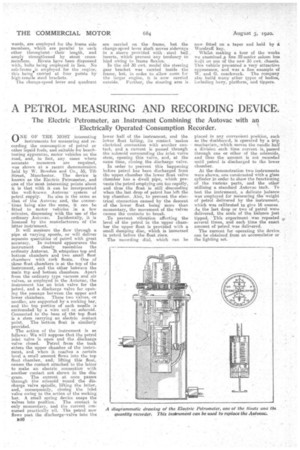A PETROL MEASURING AND RECORDING DEVICE.
Page 18

If you've noticed an error in this article please click here to report it so we can fix it.
The Electric Petrometer, an Instrument Combining the Autovac with an Electrically OperatedConsumption Recorder.
oNE OF THE MOST interesting instruments for measuring and recording the consumption of petrol or other liquid fuels, and suitable for benchtesting apparatus, motor vehicles on the road, and, in fact, any eases where accurate measures are required, was shown at a recent demonstration held by W. Bowden and Co., 55, Tit) Street, Manchester. The device is known as the Electric Petrometer, and one of the most interesting points about it is that With it can be incorporated the well-known Autovac system of
petrol supply. Its sire is the same as that of the Autovac and, the connections being also the same, it can he fitted to motor vehicles in a few minutes, dispensing with the nee of the ordinary Autovac. Incidentally, it is licensed by the manufacturers of the Idtter instrument. •
It will measure the flow through a pipe at varying speeds, or will deliver separate quantities of petrol with great accuracy. in outward appearance the instrument closely resembles the ordinary Autovac. It cdniprises top and bottom chambers and two small float chambers with Cork floats. One of these float chambers is at the top of the instrument, and the other between the main Von and bottom chambers. Apart from the; ordinary type vac-wean and air valves, as employed in the Autovac, the instrument has an inlet valve for the petrol, and a. discharge valve for evening the passage between the upper and lower chainhers. These two valves, or needles, are supported by a reeking bar, and the top portion of each needle is surfountiedby a wire coil or solenoid. Connected to the base of. the top float is a stem carrying an electric contact
point. The 1;0U-um float is similarly provided. • The action of the instrument is as fellows: We will suppose that the petrol inlet valve is open and the discharge valve closed. Petrol from the tank enters the -upper chamber of the instrument, and when it reaches a certain level a small amount flews into the top float chamber, and; lifting this float, causes the contact attached to the latter to make an electric connection with another contact not shown in the diae gram. The current at once passes through the solenoid round the discharge valve spindle, lifting the latter, and, consequently, closing the inlet valve owing to the action to the rocking bar. A small spring device snaps the
valves into position. The contact is only mem-entary, and the current consumed practically nil. The petrol now flows past the discharge-valve into the
MO lower half of the instrument, and the loWer float falling, its contact 'makes electrical connection with another contact, and a current is passed through the solenoid surrounding the inlet valve stem, opening this valve, and, at the same time, closing the discharge valve.
In order to prevent this happening before petrol has been discharged from the upper. clamber the lower float valve chamber has a dwell pipe, which prevents the petrol emptying out too rapidly, and thus the float is still 'descending when the last drop of petrol has left the top chamber. Also, to prevent the electrical connection, caused by the descent of the lower float being more than momentary, the movement of the valves causes the contacts to break.
To prevent vibration affecting the level of the petrol in the upper chamber the upper float is provided with a small damping disc, which is immersed in petrol before the float rises-.
The -recording dial, which can be placed in any convenient position, such • as the dashboard, is operated by a trip mechanism,, which moves the needle half a division each time current is, passed through one or other of the solenoids, and thus the amount is not recorded until petrol is discharged to the lower chamber.
At the 'demonstration two instruments were shown, one constructed with a glass cylinder in order to show the functioning of the various parts, and the ether utilizing a standard Autovac tank. To test the instrument, a delicate balance was employed for measuring the' weight of petrol delivered by the instrument, which was calibrated to give 16 ounces. As the last drop or two of petrol were delivered, the scale of the balance just tipped. This experiment was repeated several times, and each time the exaet amount of petrel was delivered.
The current. for operating the device can be obtained from an accumulator or the lighting set.






























